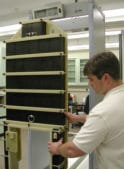CISPR 15, ed. 7.2 (2009-01) is entitled “Limits and methods of measurement of radio disturbance characteristics of lighting and similar equipment.” This standard applies to the emission (radiated and conducted) of radio-frequency disturbances from all lighting equipment with a primary function of generating and/or distributing light intended for illumination purposes, and … [Read more...]
Raytheon Climate Sensor Passes EM Testing
A sensor developed by Raytheon Company to increase understanding of how aerosols affect climate has demonstrated in testing that it would neither emit nor be impacted by interference from any electromagnetic impulses it might encounter in space. Raytheon’s Aerosol Polarimetry Sensor also completed vibration testing successfully. Next, the sensor will undergo a final test … [Read more...]
Proposed Federal Legislation Would Foil Felons’ Cell Phone Use
U.S. Senator Kay Bailey Hutchinson (R-TX) at left and U.S. Representative Kevin Brady (R-TX) have introduced legislation, the Safe Prisons Communications Act of 2009. The legislation would allow the Director of the Federal Bureau of Prisons, a state Governor, or a Governor’s designee (depending on whether the facility is federally or state operated) to submit a petition to the … [Read more...]
Towards an EMC Technology Roadmap
A technology roadmap is a tool for attaining the optimum development within a sector of technology Marcel Van Doorn, Phillips Electromagnetics & Cooling Competence Center Eindhoven, the Netherlands Introduction This article expands earlier work on the concept of a technology roadmap for EMC technology.1 Just as a traditional terrestrial map helps insure that travelers … [Read more...]
Fiber Optic Signal Conditioner Targets HERO and EED Testing
The Model FPI-HS/HE from FISO Technologies has been crafted to measure small current with more resolution and speed to meet the demands of HERO and EED testing used in military and aerospace weapon systems. This device completes FISO’s line of devices targeting HERO/EED testing applications, is compatible with its FOT-HERO sensor, utilizes proprietary White-Light Interferometry … [Read more...]
Parvus Wins Contract to Ruggedize Wireless Access Points for USN Destroyers
New Jersey-based Parvus Corporation has won a $700,000 contract from defense giant Lockheed Martin for developing, testing, and supplying a pre-production, ruggedized version of the Cisco Aironet wireless access point for Zumwalt, the U.S. Navy’s lead ship of next generation destroyers. Parvus will repackage COTS (commercial-off-the-shelf) Cisco Aironet technology to meet the … [Read more...]
UK University Launches Research to Protect Aircraft from EMI
Researchers at the University of York’s Department of Electronics have won a €1 million European grant to improve aircraft design that minimizes the risk of electromagnetic interference. At present, aircraft are thoroughly tested for electromagnetic vulnerability, but often testing comes during the later stages of the production project. The effort at York is part of a €28 … [Read more...]
Georgia Firm’s Tracking Device Receives HERO Certification from DoD
Numerex Corporation recently announced the successful completion of testing of its SX1 satellite tracking device under the Cooperative Research and Development Agreements with US Transportation Command (USTRANCOM). After HERO (Hazards of Electromagnetic Radiation to Ordnance) testing, Numerex received HERO certification, which, along with successful environmental testing, … [Read more...]
Life Enhancing Medical Products Achieve EMC Compliance
Surface cleanliness is critical to good coating adhesion for any coating process Rocky R. Arnold, Ph.D. WaveZero, Inc. Sunnyvale, CA Many medical product manufacturers achieve electromagnetic compliance (EMC) for their electronic devices by coating the inside of the plastic enclosures with a conductive material; for example, silver-copper particle loaded paint, electroplated … [Read more...]
NIST Develops Electromagnetic Phantom for Testing Metal Detectors
The National Institute of Standards (NIST) has developed an electromagnetic “phantom”—a carbon and polymer mixture that simulates the human body—that is intended to improve and standardize the testing of walk-through metal detectors. Currently, detectors are tested using human volunteers carrying various metallic objects or pieces of plywood on which the objects are mounted. … [Read more...]
- « Previous Page
- 1
- …
- 120
- 121
- 122
- 123
- 124
- …
- 145
- Next Page »














